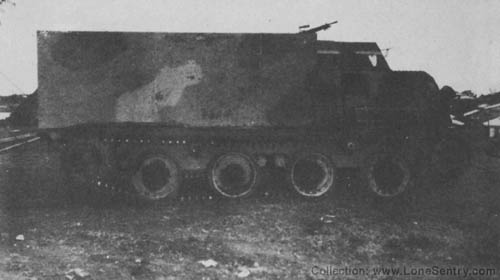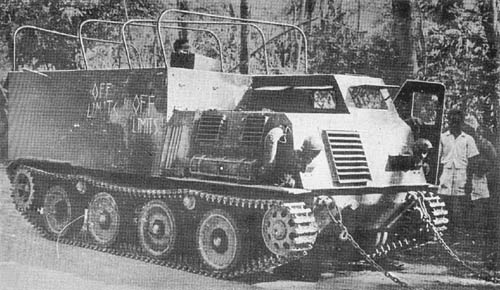The Japanese produced a limited number of the innovative Type 1 Ho-Ki, fully-tracked armored personnel carriers. The Ho-Ki APC was developed in 1941, but full-scale production did not start until 1944. A limited number of Ho-Ki were deployed with Japanese reinforcements to the Philippines in 1944, and several Ho-Ki were captured by the U.S. on Leyte and Luzon.
From Enemy on Luzon: An Intelligence Summary:
Although not encountered before our return to the Philippines, several of these vehicles were captured there by U.S. forces. One was recovered on Leyte, and at least four were found on Luzon.
Full Track Personnel Carrier
The vehicle was full tracked, armored, and powered by a six cylinder air-cooled Diesel engine. The bogie wheels and suspension were similar to those of the Type 95 Light Tank, but the track was both longer and wider than that of the tank. This carrier, 15 feet 9 inches long overall and 6 feet 8 inches wide, was protected with ¼-inch armor on all sides and rear, but was open at the top except for the driver’s compartment. There were doors at the rear and one on each side to permit personnel to leave the carrier rapidly. The driver’s compartment was on the left front of the body and was equipped with metal vision slits for driving under fire. The vehicle had four speeds forward in addition to high and low range transfer case and was equipped with a spring-mounted towing pintle.
Being much lighter than the Type 95 Light Tank, employing an engine of similar power, and having roughly the same track contact, the vehicle gave excellent cross-country performance. The addition of the transfer case increased the range and power as compared with a light tank. U.S. combat troops found these vehicles to be highly satisfactory artillery prime movers.
An additional U.S. intelligence report and photograph of the “Ho-Ki Armored Tracked Personnel Carrier” appeared in the Catalog of Enemy Ordnance:
This vehicle serves as an artillery prime mover and as a personnel carrier for 24 men. It appears to be of recent manufacture, and its first known appearance in combat was during the Leyte campaign in the Philippines.
It is a full-tracked vehicle armored with 1/4-inch plate throughout. The engine which is located at the right front of the body is a 6-cylinder, in-line, valve-in-head, air-cooled diesel of a type similar to those used in the Model 2595 light tank and the combination prime mover and wrecker. Two fuel tanks provide an estimated total capacity of 50 to 60 gallons.
The tracks and suspension are of the conventional Japanese design, using dual bogie wheels and a steel center guide track. The four bogie wheels, apparently identical with those on the Model 2595 light tank, are mounted on bell cranks and are sprung by horizontal coil springs which are inclosed within the body armor with only the bogie arms exposed. There are two return rollers. The track is driven from the rear. A clutch and brake steering system is used. The transmission provides four speeds forward and one reverse. A high and low transfer case is also provided.
A mount for a 7.7 mm machine gun is located on the left front of the driver’s compartment. The vehicle does not mount a winch, but is provided with a spring mounted towing pintle for use as a prime mover. It has a capacity of from 2 to 3 tons if used as a cargo carrier. Maximum speed is reported as approximately 35 miles per hour, with exceptionally good cross-country performance due to the amount of track area in contact with the ground in relation to the weight of the vehicle.
SPECIFICATIONS
Length (overall) 15 ft., 9 ins. Width (overall) 6 ft., 8 ins. Ground contact 9 ft., 10 ins. Width of track 10 ins. Pitch of track 3-13/16 ins. Track links 125 Speed (maximum) 35 m.p.h. Armor (reported) 1/4 in. Armament 7.7 mm machine gun Engine 6-cylinder, in-line, valve-in-head, diesel. Transmission 4 speeds forward, 1 reverse; high and low range. Steering Clutch and brake system Seating capacity 24












Neat vehicle.
Entertaining article. Many thanks